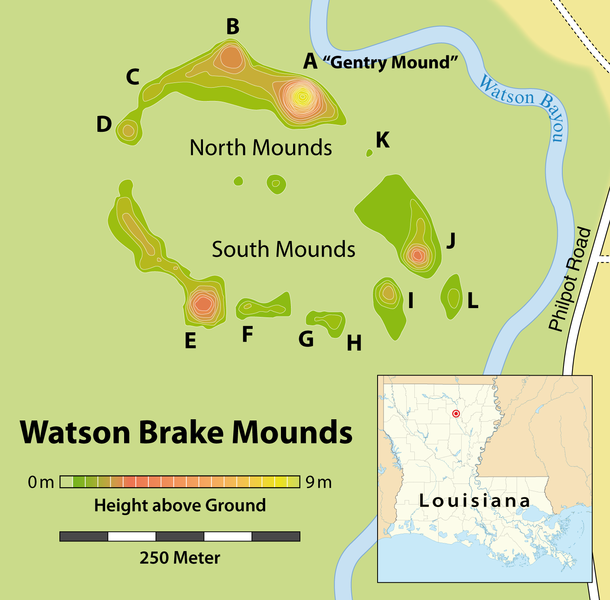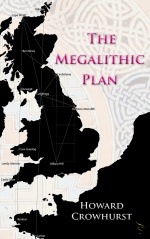<< Image Pages >> Watson Brake - Artificial Mound in United States in The South
Submitted by bat400 on Saturday, 28 May 2011 Page Views: 16469
Pre-ColumbianSite Name: Watson Brake Alternative Name: Ouachita Mounds, Watson's BrakeCountry: United States
NOTE: This site is 15.773 km away from the location you searched for.
Region: The South Type: Artificial Mound
Nearest Town: Monroe
Latitude: 32.369222N Longitude: 92.130278W
Condition:
| 5 | Perfect |
| 4 | Almost Perfect |
| 3 | Reasonable but with some damage |
| 2 | Ruined but still recognisable as an ancient site |
| 1 | Pretty much destroyed, possibly visible as crop marks |
| 0 | No data. |
| -1 | Completely destroyed |
| 5 | Superb |
| 4 | Good |
| 3 | Ordinary |
| 2 | Not Good |
| 1 | Awful |
| 0 | No data. |
| 5 | Can be driven to, probably with disabled access |
| 4 | Short walk on a footpath |
| 3 | Requiring a bit more of a walk |
| 2 | A long walk |
| 1 | In the middle of nowhere, a nightmare to find |
| 0 | No data. |
| 5 | co-ordinates taken by GPS or official recorded co-ordinates |
| 4 | co-ordinates scaled from a detailed map |
| 3 | co-ordinates scaled from a bad map |
| 2 | co-ordinates of the nearest village |
| 1 | co-ordinates of the nearest town |
| 0 | no data |
Be the first person to rate this site - see the 'Contribute!' box in the right hand menu.
Internal Links:
External Links:
I have visited· I would like to visit
Andy B has visited here

The eleven oval and circular mounds were built on a hill overlooking the Ouachita River. The tallest of the group was over 20 feet tall originally.
The mounds date back to 3400 BC, older than the mounds at Poverty Point. With no burials, and few artifacts, or even signs of use after their initial building, the mounds are assumed to have had some ceremonial use, even if it were only a unique exercise in marking group identity or a singular instance of focused coercion.
The people who created the Watson Brake mounds did not live on the site. Evidence of habitation from the same period in Louisiana indicates the people had not yet developed agriculture in any focused way, and led lives of seasonal settlement.
The location given is for the watercourse of Watson Break and not the site itself, which is located on properties owned by the Archaeology Conservancy and a private owner. Currently several of the mounds are covered by trees and other vegitation. The site us not accessible to the public at this time.
You may be viewing yesterday's version of this page. To see the most up to date information please register for a free account.

Do not use the above information on other web sites or publications without permission of the contributor.
Click here to see more info for this site
Nearby sites
Click here to view sites on an interactive map of the areaKey: Red: member's photo, Blue: 3rd party photo, Yellow: other image, Green: no photo - please go there and take one, Grey: site destroyed
Download sites to:
KML (Google Earth)
GPX (GPS waypoints)
CSV (Garmin/Navman)
CSV (Excel)
To unlock full downloads you need to sign up as a Contributory Member. Otherwise downloads are limited to 50 sites.
Turn off the page maps and other distractions
Nearby sites listing. In the following links * = Image available
4.8km SE 133° Filhiol Mound Artificial Mound
16.7km SE 130° Landerneau Mounds Artificial Mound
34.3km SSE 162° Wade Landing Mound Artificial Mound
43.9km NE 50° Jordan Mounds Site Artificial Mound
53.8km NNW 327° Scott Place Mounds* Artificial Mound
59.9km NW 305° Hedgepeth Mounds Artificial Mound
61.3km E 88° Insley Mounds* Artificial Mound
61.4km ENE 78° Marsden Mounds* Artificial Mound
64.3km SSE 150° Boothe Landing Mound Artificial Mound
67.6km SSE 154° Alexander Mound Artificial Mound
67.9km NNE 29° Venable Mound Artificial Mound
69.6km NNE 29° Caney Bayou Mound Artificial Mound
70.9km ESE 115° Ghost Site Mounds Artificial Mound
71.9km E 84° Tendal Mound* Artificial Mound
72.6km ENE 68° Lower Jackson* Artificial Mound
72.7km SSE 157° Harrisonburg Mounds Artificial Mound
73.7km ENE 66° Poverty Point - Mound A* Artificial Mound
73.9km SSE 157° McGuffee Mounds Ancient Village or Settlement
74.2km ENE 66° Poverty Point* Ancient Village or Settlement
74.2km ENE 66° Poverty Point - Earthworks* Ancient Village or Settlement
75.5km SE 143° Peck Mounds Artificial Mound
78.4km ENE 61° Mott Archaeological Preserve Artificial Mound
78.9km SSE 158° Tew Lake Mounds Artificial Mound
80.1km SSE 157° Routon Mounds Artificial Mound
81.6km ESE 107° Shackleford Church Mounds Artificial Mound
View more nearby sites and additional images






 We would like to know more about this location. Please feel free to add a brief description and any relevant information in your own language.
We would like to know more about this location. Please feel free to add a brief description and any relevant information in your own language. Wir möchten mehr über diese Stätte erfahren. Bitte zögern Sie nicht, eine kurze Beschreibung und relevante Informationen in Deutsch hinzuzufügen.
Wir möchten mehr über diese Stätte erfahren. Bitte zögern Sie nicht, eine kurze Beschreibung und relevante Informationen in Deutsch hinzuzufügen. Nous aimerions en savoir encore un peu sur les lieux. S'il vous plaît n'hesitez pas à ajouter une courte description et tous les renseignements pertinents dans votre propre langue.
Nous aimerions en savoir encore un peu sur les lieux. S'il vous plaît n'hesitez pas à ajouter une courte description et tous les renseignements pertinents dans votre propre langue. Quisieramos informarnos un poco más de las lugares. No dude en añadir una breve descripción y otros datos relevantes en su propio idioma.
Quisieramos informarnos un poco más de las lugares. No dude en añadir una breve descripción y otros datos relevantes en su propio idioma.